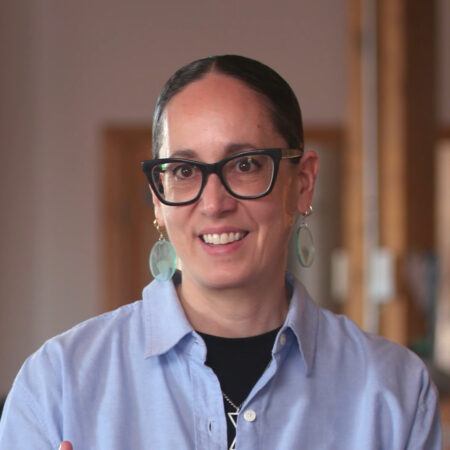Dyani White Hawk

Dyani White Hawk was born in 1976 in Madison, Wisconsin, and currently lives and works in Minneapolis, Minnesota. She received her Associate in Arts Degree from the Haskell Indian Nations University, her Bachelor’s in Fine Arts from the Institute of American Indian Arts, and her Master’s in Fine Arts from the University of Wisconsin-Madison. Across varied media, including painting, beadwork, mosaic, video, and performance, White Hawk brings attention to the traditions, techniques, and aesthetics of Lakota art practices, celebrating their beauty and conceptual rigor and placing them in the lineage of Western abstraction.
White Hawk’s work is deeply rooted in painting and beadwork, drawing upon the practices of both Lakota and Western Modernist abstraction. In works like Wopila|Lineage (2022), the artist directly employs the visual languages of Lakota beadwork, creating a 14-foot-long painting with more than 500,000 glass beads that are woven together to form seven hourglass figures or Kapemni, a symbol for the mirroring between earth and sky. In other works, like the painting series Quiet Strength, White Hawk interweaves multiple histories of abstraction, referencing the parallel bands of porcupine quillwork and the grid paintings of Agnes Martin. “Our artistic practices are reflections of our existences, our artistic practices are reflections of our society,” says the artist. “If we’re only speaking to that history from a singular perspective, we are leaving out so much of the story.”
Through painting and sculpture, the artist confronts the hierarchies that devalue Lakota and Native art. In works like Before Seeing You For Awhile Now (2011), Untitled (blue and gold) (2016), and Untitled (All the Colors) (2020), the artist works with the elongated ovoid shapes of the moccasin set against backdrops that reference histories of stripe painting and color field abstraction in Modernism. In her series of sculptures Carry, the artist adorns copper vessels and tobacco bags with beadwork, buckskin fringe, and dyed feathers, calling attention to the rich aesthetic value of these objects that also hold utilitarian functions. “Native art has historically been othered. It is craft, or design, or self-taught, or ethnographic, or anthropological. Anything outside of this is just art,” says the artist. Across her body of work, White Hawk creates opportunities for critical reflection on Western art history, inviting viewers to expand on their understanding of abstraction beyond the typical art historical canon and offering a vision for a visual culture that we can all share.
“The foundation of my painting lives within my relationship to our greater visual culture. And a lot of that, for me, the entry point was through beadwork.”
Dyani White Hawk
